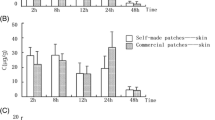Summary
The penetration, permeation, and resorption of radioactively labelled 8-Methoxypsoralen was investigated in human skin. Simultaneously, the effects of time and ointment carrier on the penetration kinetics were ascertained. The carriers tested were: vaseline, aqueous wool-wax alcohol ointment, aqueous hydrophilic ointment and polyethylene glycol ointment. The absolute concentrations of 8-Methoxypsoralen were estimated in the horny layer, epidermis and dermis. With the most advantageous carrier, aqueous wool-wax alcohol ointment, 4–6 × 10−5 M and 10−5 M were attained in the epidermis and dermis, respectively. Moreover, it was shown that the substance penetrates rapidly (10 min) into the epidermis and dermis and the high concentrations reached remained constant over a period of 16 h.
Only with a formulation of aqueous wool-wax alcohols is any accumulation at all achieved in the deeper areas of the horny layer. A uniform decrease in drug concentration with increasing depth of the horny layer is found with the other 3 vehicles, whereby slight variations in concentrations pertain from carrier to carrier. 4 h after local application, 8-Methoxypsoralen can be detected in the urine. Regardless of the ointment base employed, 8-Methoxypsoralen is no longer detectable in the urine 40 h after application.
In comparison to the oral therapy, the same magnitude of percutaneous resorption into the central compartment is to be derived from the data, if half the body surface is treated locally.
Zusammenfassung
Die Penetration, Permeation und Resorption von radioaktiv markiertem 8-Methoxypsoralen wurde an menschlicher Haut untersucht. Gleichzeitig wurde die Abhängigkeit der Penetration von der Applikationsdauer und der verwendeten Salbengrundlage (Vaseline, wasserhaltige Wollwachsalkoholsalbe, wasserhaltige hydrophile Salbe und Polyäthylenglykolsalbe des Deutschen Arzneibuches (DAB 7) ermittelt. Es konnten Absolutkonzentrationen von 8-Methoxypsoralen in Hornschicht, Epidermis und Corium angegeben werden. Sie waren bei Verwendung des günstigsten Vehikels (wasserhaltige Wollwachsalkoholsalbe DAB 7) in der Epidermis 4–5 ⋅ 10−6 molar und im Corium 4–5 ⋅ 10−7 molar. Dabei zeigte sich, daß die Substanz schnell (10 min) in die Epidermis und das Corium eindringt und die schon anfänglich hohen Konzentrationen bis 1000 min Einwirkungszeit etwa konstant bleiben.
In den unteren Hornschichtlagen kommt es allein bei der wasserhaltigen Wollwachsalkoholsalbe zu einer gewissen Anreicherung der markierten Substanz, die anderen Vehikel bewirken eine unterschiedlich große, jedoch gleichmäßig zur Tiefe hin abfallende Substanzverteilung in der Hornschicht. Vier Stunden nach der lokalen Applikation ist 8-Methoxypsoralen im Urin nachweisbar, nur bei Verwendung von Polyäthylenglykol als Vehikel, dauert die Ausscheidung doppelt so lange. Unabhängig von der Salbengrundlage ist ab ca. 40 h nach der Applikation kein 8-Methoxypsoralen mehr im Harn nachweisbar. Anhand der gefundenen Ergebnisse werden Hinweise für eine mögliche Verbesserung der Therapie mit 8-Methoxypsoralen gegeben.
Similar content being viewed by others
References
Wacker, A., Chandra, R., Musajo, L., Rodighiero, G., Ippen, H.: U. Gallo, L. Santamaria, Editors, Research Progress in Organic, Biological and Medical Chemistry Vol 3, Part. 1 + 2. Amsterdam-London: North-Holland Publ. Comp. 1972
Chandra, P., Kraft, S., Wacker, A.: Studies on the Reactivation of Bacteria Photodamaged by Psoralen. Biophysik7, 251–258 (1971)
Zesch, A., Schaefer, H.: Penetration Kinetics of Four Drugs in the Human Skin. Acta derm.-venereol. (Stockh.)54, 91–98 (1974)
Hoffmann, W. D., Zesch, A., Schaefer, H.: Vehikelabhängige Penetration zweier Steroide bei gleichzeitiger Applikation auf die menschliche Haut. Arch. Derm. Forsch.250, 295–308 (1974)
Schaefer, H., Zesch, A.: Wechselbeziehungen zwischen Haut, Vehikel und Arzneimittel bei der Penetration in die menschliche Haut: 1 und II. Fette, Seifen, Anstrichmittel76, 220–222 and 312-318 (1974)
Zesch, A., Schaefer, H.: Penetrationskinetik von radiomarkiertem Hydrocortison aus verschiedenen Salbengrundlagen in die menschliche Haut — in vitro. Arch. Derm. Forsch.246, 335–354 (1973)
Zesch, A., Schaefer, H.: Penetrationskinetik von radiomarkiertem Hydrocortison aus verschiedenartigen Salbengrundlagen in die menschliche Haut II. In vivo. Arch. Derm. Forsch.225, 245–256 (1975)
Schaefer, H., Zesch, A., Bauer, E.: unpublished results. (1975)
Author information
Authors and Affiliations
Additional information
This work was supported by the Deutsche Forschungsgemeinschaft.
Rights and permissions
About this article
Cite this article
Kammerau, B., Klebe, U., Zesch, A. et al. Penetration, permeation, and resorption of 8-methoxypsoralen. Arch. Derm. Res. 255, 31–42 (1976). https://doi.org/10.1007/BF00581675
Received:
Revised:
Issue Date:
DOI: https://doi.org/10.1007/BF00581675




